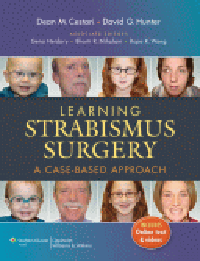<斜視手術の学習>
Learning Strabismus Surgery
- A Case-Based Approach

| 著者 | : D.M.Cestari & D.G.Hunter (eds.) |
|---|---|
| 出版社 | : WOLTERS KLUWER |
| ISBN | : 978-1-4511-1660-1 |
| ページ数 | : 241pp. |
| 出版年 | : 2013年 |
在庫
定価39,402円(本体35,820円 + 税)
※在庫表示「なし」の商品は海外発注にて注文を承ります。概ね4〜6週間で取寄可能です(「近刊」の商品は刊行後の入荷・発送になります)。
なお、海外発注後のキャンセルはお受けできかねますのでご了承ください。
- 商品説明

本書の特色
症例に基づくアプローチを用いて各難易度の複雑な斜視手術を概念化し,計画し,実施できるようにする,実践的なリソース.斜視手術をより確実に理解しようとする学生,および臨床における意思決定の向上を目指す経験豊富な外科医の双方に最適な内容となっている.
斜視手術の経験豊富な外科医の確かな技術によってガイドされており,それぞれ特有の臨床所見を伴う複雑な症例を検証し,情報を分析し,手術進入法を選択し,手術の詳細な計画をたてることができる.
各症例の最後に所見をレビューし,有効だった点,およびより有効な方法があった点を考察する.さらに,簡潔な設問で重要概念を定着させる.
【ここに注目!】
・52例の実際の症例によって,手術の概念を適用し,患者のアウトカムを最適化することができる.
・「基礎」から「エキスパート」までの難易度がラベルで示され,焦点となっているレビューの複雑さを正確に知ることができる.
・幅広い相互参照により,レビューの必要のある症例に必要な時に注目させる.
・専門医の視点は,複雑な症例を評価し,オプションを比較検討し,臨床における選択を精査するために有用である.
・広範なビデオ・ライブラリーで専門医の手術の場面を見ることができる.
・復習問題で記憶を向上させ,専門医試験対策を容易にする.
・使いやすい構成で手術に関する重要情報を要約し,一冊のリファレンスにまとめている.
Case Title
Partially accommodative esotropia / Pseudodivergence excess exotropia / 4th nerve palsy with botulinum toxin trial / Congenital nystagmus / Traumatic sixth nerve palsy / V-Esotropia After LASIK / Post-traumatic sensory exotropia / Esotropic Duane syndrome type 1 in an adult / Large-angle congenital esotropia / Diplopia after cataract surgery in a patient with vascular disease / 6th nerve palsy from a diffuse intrinsic pontine glioma / Restrictive strabismus after pterigium surgery / Bilateral superior oblique palsy / Exotropia with V pattern / Thyroid eye disease / Brown syndrome / Consecutive exotropia with pseudotendon / Esotropic Duane syndrome type 1 in a child / Exotropia with a history of strabismus surgery / Large hypertropia in an infant treated with adjustable sutures / Increased esotropia after attempted correction / Strabismus following ruptured globe / Exotropia and amblyopia / Botulinum toxin for acute, comitant esotropia / Chronic progressive external ophthalmoplegia / Thyroid eye disease with a twist / Adduction limitation 50 years after surgery for congenital esotropia / Congenital 4th nerve palsy in a child / Longstanding exotropia in an adult / Semi-adjustable inferior rectus recession / Acute 6th nerve plasy with spread of comitance in a patient with multiple / Traumatic sixth nerve palsy in a functionally monocular patient / Diplopia and difficulty swallowing after cataract extraction / Skew deviation / Complex strabismus with large fixation disparity / Bilateral sixth nerve palsies...etc.




